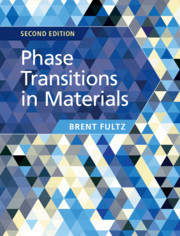Book contents
- Frontmatter
- Contents
- Preface
- Notation
- Part I Basic Thermodynamics and Kinetics of Phase Transformations
- Part II The Atomic Origins of Thermodynamics and Kinetics
- Part III Types of Phase Transformations
- 11 Thermodynamics and Phase Transitions at Surfaces
- 12 Melting
- 13 Solidification
- 14 Phase Transformations with Interfaces: 1. Microstructure
- 15 Phase Transformations with Interfaces: 2. Energetics and Kinetics
- 16 Spinodal Decomposition
- 17 Phase Field Theory
- 18 Method of Concentration Waves and Chemical Ordering
- 19 Diffusionless Transformations
- 20 Thermodynamics of Nanomaterials
- 21 Magnetic and Electronic Phase Transitions
- Further Reading
- References
- Index
19 - Diffusionless Transformations
from Part III - Types of Phase Transformations
Published online by Cambridge University Press: 24 April 2020
- Frontmatter
- Contents
- Preface
- Notation
- Part I Basic Thermodynamics and Kinetics of Phase Transformations
- Part II The Atomic Origins of Thermodynamics and Kinetics
- Part III Types of Phase Transformations
- 11 Thermodynamics and Phase Transitions at Surfaces
- 12 Melting
- 13 Solidification
- 14 Phase Transformations with Interfaces: 1. Microstructure
- 15 Phase Transformations with Interfaces: 2. Energetics and Kinetics
- 16 Spinodal Decomposition
- 17 Phase Field Theory
- 18 Method of Concentration Waves and Chemical Ordering
- 19 Diffusionless Transformations
- 20 Thermodynamics of Nanomaterials
- 21 Magnetic and Electronic Phase Transitions
- Further Reading
- References
- Index
Summary
Diffusionless transformations occur when atoms in a crystal move cooperatively and nearly simultaneously, distorting the crystal into a new shape. The martensite transformation is the most famous diffusionless transformation, owing to its importance in steel metallurgy. In a martensitic transformation the change in crystal structure occurs by shears and dilatations, and the atom displacements accommodate the shape of the new crystal. The atoms do not move with independent degrees of freedom, so the change in configurational entropy is negligible or small. The entropy of a martensitic transformation is primarily vibrational (sometimes with electronic entropy, or magnetic entropy for many iron alloys). This chapter begins with a review of dislocations, and how their glide motions can give crystallographic shear. Some macroscopic and microscopic features of martensite are then described, followed by a two-dimensional analog for a crystallographic theory that predicts the martensite “habit plane” (the orientation of a martensite plate in its parent crystal). Displacive phase transitions are explained more formally with Landau theories having anharmonic potentials and vibrational entropy. Phonons are discussed from the viewpoint of soft modes and instabilities of bcc structures that may be relevant to diffusionless transformations.
Keywords
Information
- Type
- Chapter
- Information
- Phase Transitions in Materials , pp. 482 - 510Publisher: Cambridge University PressPrint publication year: 2020
Accessibility standard: Unknown
Why this information is here
This section outlines the accessibility features of this content - including support for screen readers, full keyboard navigation and high-contrast display options. This may not be relevant for you.Accessibility Information
- 1
- Cited by
